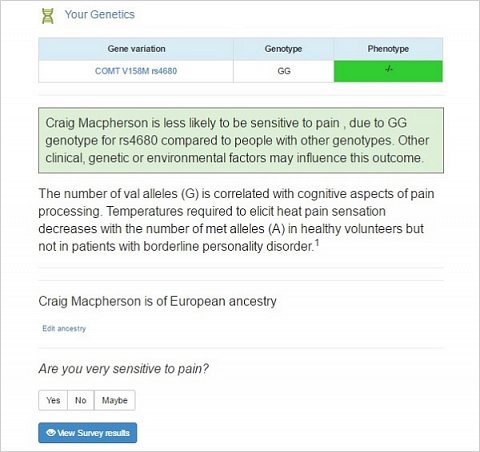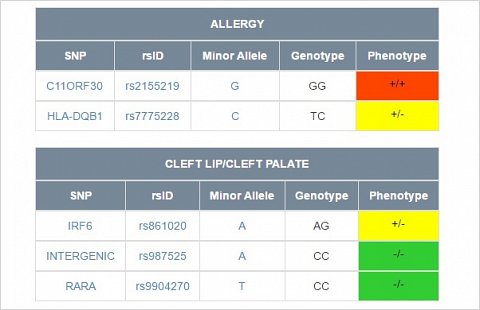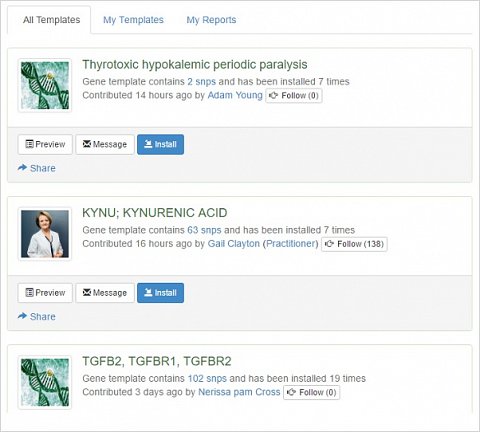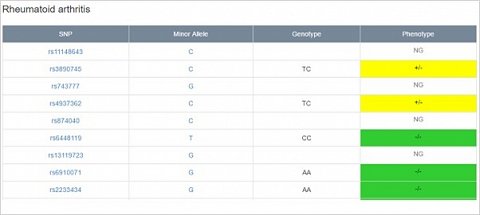-
Gene Variance Report
review on 10 October 2016
by Craig Macpherson

At a Glance
Summary
LiveWello stands out when compared to similar genetic tools due to the number of opportunities to customise my experience, and the numerous ways in which I could contribute to, and interact with my results. I was particularly impressed by the references that accompanied the results which included links to original studies, as well as to an abundance of further research resources.
The one thing that slightly let the service down was the difficulty in navigating the site. It took a while to get to grips with the features and to access the specific sections, so be prepared to explore. However, this was partly because of the wide range of features offered, which once I became familiar with them, were well explained and interesting.
Full report
Co-founded by one of the ‘20 Youngest Power Women in Africa 2012’ and her husband to help centralise the care of their autistic son, LiveWello is a service that focuses on a sense of community. The aim is to allow people to take control and fully understand their health, through sharing the details of their diagnosed conditions and genetic predispositions.
Product Expectations
LiveWello offered me the chance to use my DNA data, previously obtained through taking a home DNA test, to further explore my genetic predisposition. Although I chose to use AncestryDNA data, the service was also compatible with files from 23andMe, Family Tree DNA and Gene by Gene.
The description of the service explained that it would provide reports for 600,000 SNPs (also known as genetic variants), as well as 12 resources to help me to understand the results. LiveWello offered the choice of either a one-time payment or a subscription service. In terms of explaining the difference between the two, it seemed that the latter included health reports that were specific to each customer, and written by professionals, rather than being an automated algorithmic report. Other than that, I couldn’t really tell what else was included in the subscription service, so I chose the one-time payment option.
The privacy statement and terms of service made it clear that the information obtained did not constitute medical advice and that the data I provided would not be sold, rented or shared without my express permission. I was also pleased to see that I could delete my information and account at any time, should I change my mind about using the service. Another important point was that as it was a digital service, the fee paid was non-refundable, and that the subscription would auto-renew at the end of the period if not cancelled.
Ordering Experience
Once I had chosen the payment option, I signed up to the website by entering my name, a username of my choice, my email (which I had to verify) and a password. I then paid the $19.95 fee via PayPal and was sent confirmation via email. It took about 3 minutes to upload my DNA file, after which I was immediately able to access the reports.
I also received a series of emails which contained links to resources. These showed me how to use the service, as well as how to interpret my results. The resources were numerous and came in various forms including videos and Facebook pages. It was useful to have these links provided in an email as it meant they were easily accessible when I needed them. This allowed me to avoid having to search through the site for advice. I was also emailed a direct link to access my results.
The Results
The results were wide ranging, but were sorted into four main sections: ‘Health Reports’, ‘Variance Reports’, ‘Gene Templates’ and ‘Genome Wide Association Studies’ (GWAS). Although not strictly results, there were several other features to the service, including surveys and an SNP (genetic variant) search function, which helped me make sense of and explore the reports.
Results Section: Health Reports
The ‘Health Reports’ were probably the most substantial part of the results and felt like the central summary, from which all of the other reports branched out. Before paying for the service, I understood that I would be provided with ‘over 20 free reports’ on a range of health conditions. However, it turned out that there were actually well over 20 (28 in total) included in the analysis, which was a pleasant surprise.
Unfortunately, for many of the reports, I was told that I had ‘insufficient genotypes’ for the analysis. In total, nine of them (just over a third) included this message rather than a conclusion. Although I was not provided with any personalised information about these conditions, these results still provided me with information about relevant research and the approximate percentage of people from different populations whom are affected by them.
The help section explained that there were a few possible reasons for the ‘insufficient genotypes’ message. One was that my raw DNA data had been produced by an older analysis ‘chip’ (I took my AncestryDNA test a year ago). I learned that newer chips often allow analysis of a higher number of genetic variants and therefore provide more raw data. LiveWello also said that different companies report on different genetic variants, so it may have been that I’d have had a better range of results with raw DNA data from a different company (e.g. 23andMe).
It’s worth noting that I was only able to upload one file to my account, and so I couldn’t upload a newer version of my raw DNA data. I’d recommend that if you have more than one set of raw DNA data, that you use the most recent one to optimise your results.
There were also several reports that were only accessible to those customers that paid for the subscription service and it was quite difficult to find a section that only showed the ones I could access rather than all of the reports available. However, the reports that I could access were comprehensive. Each included a detailed yet understandable explanation of which genes were examined, what the biological results were likely to be, and what they might mean symptomatically. There was also a box that stated which genetic variant I had, and the likely physical manifestations I might experience as a consequence.
Tables were provided that listed the genetic variations sought in the analysis along with my ‘genotype’ and ‘phenotype’, but unfortunately these terms weren’t explained so the results weren’t as meaningful as they could have been. See my ‘COMT Gene and Sensitivity to Pain’ result below:

My ‘COMT Gene and Sensitivity to Pain’ result.
The social aspect of LiveWello was demonstrated beneath my results. I was invited to answer a survey question for each report, for example ‘Are you very sensitive to pain?’ for the ‘COMT Gene and Sensitivity to Pain’ result. I was also given the chance to rate the report on a scale of one to five, to comment, and to contact other LiveWello users. Finally, not only were there references citing where the information for the analysis had been sourced, but this section also included links to academic articles, allowing me to conduct further, independent research on specific conditions.
Results Section: Variance Reports
Once I had been through the Health Reports, I moved on to the ‘Variance Reports’. These were slightly more technical and less user-friendly than the Health Reports, but once I got to grips with them they were interesting and actually provided more information. This section allowed me to click on each genetic variant (labelled ‘SNP’ on the table) to see the information about it and what it might mean for my health. A section of my report is shown below:

A section of my Variance Report.
The results were sorted into mini tables containing information about specific aspects of health. There were a few terms in these tables, such as ‘rsID’, that weren’t explained, which was a shame.
An important thing to note for the Variance Reports, which was also explained by LiveWello in the legend at the bottom of each report, is that although ‘+/+’ was labelled in red, ‘+/-‘ in yellow and ‘-/-‘ in green, this didn’t necessarily indicate whether these were good or bad. A good example of this was for my C11ORF30 result; C11ORF30 being a gene that has been linked with the chances of suffering with allergies. The report showed that I was ‘(+/+)’ for C11ORF30, which I thought would indicate that I was more likely to suffer with allergies (although in reality I don’t suffer with any!). However, it turned out that this meant that I was actually less likely to suffer with allergies. My C11ORF30 result is shown below:

A section of my C11ORF30 Variance Report result.
One thing that stood out (as you can see from the above) is that some of the labels in these reports were cut off and I couldn’t find a way to see what they were.
The Variance Reports had so many features that it isn’t possible to go through them all in detail. I think that the most important point about this section is that although it seemed a little complicated and dense to start with, it was worth persevering. I was rewarded with a huge range of information, statistics and extra resources, that were well explained and provided genuinely interesting information about health related issues. Finally, as was the case for the Health Reports, the references detailing where the information was sourced were comprehensive and detailed, and the option to share the report gave me another chance to make use of the community focus of the service.
Results Section: Gene Templates
The ‘Gene Templates’ and ‘SNP Sandbox’ sections provided further examples of how social and personalised this service could be. The SNP Sandbox allowed me to create custom gene variance reports, for example, a report based on genes related to insomnia. I used the search function to find conditions and the areas of the body that they affect, and the genetic variants related to them. The genetic variants were labelled with their ‘rsIDs’, which I was worried would mean that the reports would be a bit too scientifically detailed. However, this was not the case, and when I generated the custom gene variance report it was similar to the Variance Reports I’d already seen. This allowed me to find detailed, user-friendly information about each genetic variant relevant to the condition or body part I had selected.
In addition to the custom reports that I’d run myself, there were several templates (shown below) that had been generated and shared by other users. I was also given the opportunity to share those that I made, but I could also keep them private.

Three of the custom reports that had been shared by other users.
Results Section: Genome Wide Association Studies (GWAS)
The final part of the service that I went through was the GWAS section. This was based on studies that looked at lots of different people’s DNA, across the whole genome (all of your DNA). GWAS allow researchers to find genetic variants that are found most frequently in those with certain conditions, to establish further links between genetics and disease. The tool itself let me search conditions to see which genetic variants have been associated with them.
My grandma has suffered from rheumatic problems from a young age, so I was interested to see if any of my genes had been associated with this condition. It was easy to look this up and I was provided with a long list of genetic variants and whether I possessed them, and corresponding ‘rsIDs’ that I could click on to find out more information. There was also a legend at the bottom which explained parts of the table such as ‘NG’ which stood for ‘Not genotyped’ – in these cases, the report I’d uploaded to LiveWello didn’t show whether I possessed these variants or not.

My GWAS Rheumatoid Arthritis result.
Summary
LiveWello stands out when compared to similar genetic tools due to the number of opportunities to customise my experience, and the numerous ways in which I could contribute to, and interact with my results. I was particularly impressed by the references that accompanied the results which included links to original studies, as well as to an abundance of further research resources.
The one thing that slightly let the service down was the difficulty in navigating the site. It took a while to get to grips with the features and to access the specific sections, so be prepared to explore. However, this was partly because of the wide range of features offered, which once I became familiar with them, were well explained and interesting.


